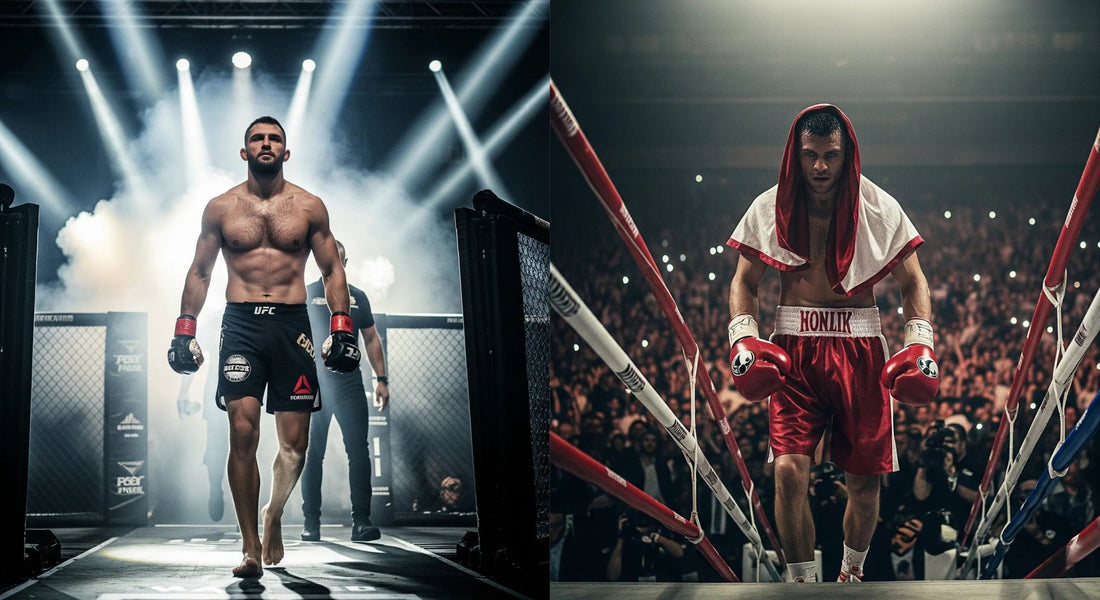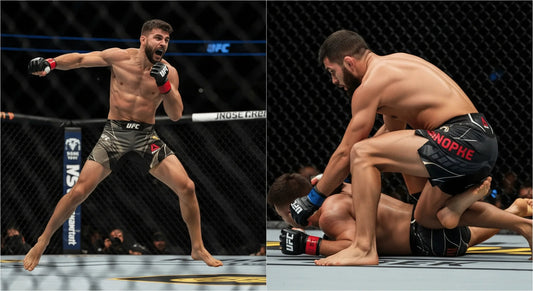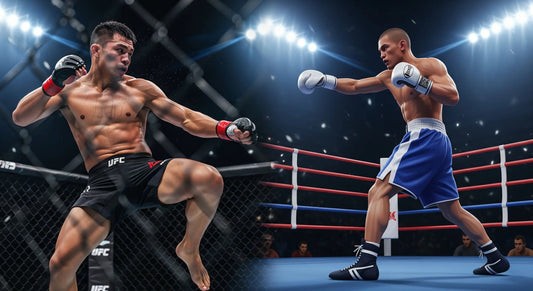
MMA Training vs Boxing – Which One Should You Choose?
Introduction to Combat Sports
Combat sports have fascinated people for centuries. Whether it’s the raw explosiveness of boxing or the all-encompassing nature of mixed martial arts (MMA), these disciplines attract millions worldwide. Each sport has its own training methods, philosophies, and unique benefits, making them appealing for very different reasons. Choosing between MMA and boxing isn’t just about picking a sport; it's about choosing a lifestyle, a mindset, and even a community.

The Rise of MMA
In the past two decades, MMA has skyrocketed in popularity, thanks to organizations like the UFC, Bellator, and ONE Championship. Unlike traditional combat sports, MMA blends multiple martial arts into one: wrestling, jiu-jitsu, boxing, kickboxing, and Muay Thai. This creates a more dynamic and unpredictable fighting style.
Training in MMA is often compared to learning several sports at once. Fighters must master grappling, striking, and clinching techniques. For example, an MMA fighter may need to train in Brazilian Jiu-Jitsu in the morning, striking in the afternoon, and wrestling drills at night. The result? A highly versatile athlete capable of handling almost any situation inside the cage.

But MMA isn’t just about fighting. Many people join MMA gyms for fitness, self-defense, or personal growth. It offers a full-body workout, improves mental toughness, and pushes you to your physical limits. That’s why MMA training appeals to people who want variety and love challenges.
Boxing

Boxing, often called "the sweet science," has a history that stretches back thousands of years. Unlike MMA, boxing focuses solely on punches, jabs, hooks, uppercuts, and combinations. On the surface, it may seem simpler than MMA, but boxing is a deeply technical sport where precision, timing, and footwork matter more than brute force.
The training style in boxing reflects this simplicity and depth. Boxers spend hours perfecting their jab, working on head movement, and mastering defensive techniques. A typical boxing session includes shadowboxing, heavy bag work, pad drills, and sparring.
Boxing has also given us some of the greatest athletes in history: Muhammad Ali, Mike Tyson, Floyd Mayweather, and Manny Pacquiao. Their legacies prove that boxing isn’t just a sport’s an art form. For fitness enthusiasts, boxing provides a phenomenal cardiovascular workout while also sharpening reflexes and coordination.
While MMA may represent the evolution of combat sports, boxing remains a timeless sport that continues to inspire millions across the globe.
Understanding MMA Training
What Does MMA Training Include?
MMA training is unique because it requires athletes to train in multiple martial arts simultaneously. Unlike boxing, where the focus is only on punches, MMA demands versatility. Fighters need to be comfortable both on their feet and on the ground.
Here’s what a typical MMA training schedule might include:
-
Striking Training: Boxing, kickboxing, and Muay Thai drills for punches, kicks, knees, and elbows.
-
Grappling Training: Wrestling, judo, and Brazilian Jiu-Jitsu for takedowns, submissions, and ground control.
-
Strength & Conditioning: Weightlifting, plyometrics, sprints, and endurance exercises to build explosive power.
-
Sparring: Full-contact sessions to simulate real fight scenarios.
-
Strategy & Game Planning: Fighters study opponents, analyze fight tapes, and practice specific tactics.
This variety makes MMA one of the most demanding sports in the world. A fighter must constantly improve in all areas because neglecting one can become a weakness inside the cage. For example, a great striker without grappling skills risks being dominated on the ground.

But it’s not just professionals who benefit from this training. Many people join MMA gyms for fitness and self-defense. Even a beginner can enjoy MMA classes without competing. These sessions typically include pad work, light sparring, and conditioning, making them suitable for all fitness levels.
The Importance of Cross-Disciplinary Skills
What separates MMA from boxing is the sheer diversity of skills required. A boxer may only train punches, but an MMA fighter must train kicks, takedowns, grappling, and submissions. This cross-disciplinary approach makes MMA fighters more well-rounded athletes.
For example, imagine an MMA fighter facing a pure boxer. If the fight stays standing, the boxer might have the advantage. But the MMA fighter can use leg kicks, clinches, or takedowns to neutralize the boxer’s strengths. That adaptability is what makes MMA so fascinating.
Cross-training also builds resilience. Fighters have to constantly step outside their comfort zone. A wrestler may feel awkward striking, while a kickboxer may struggle with grappling. By learning multiple arts, fighters develop humility, patience, and a deeper understanding of combat.
From a fitness perspective, cross-disciplinary training prevents monotony. One day you’re practicing explosive takedowns, the next you’re perfecting combinations on pads, and another day you’re rolling on the mats practicing submissions. This variety keeps workouts exciting and challenges the body in different ways, leading to balanced athletic development.
Strength and Conditioning in MMA
Strength and conditioning are the backbone of MMA performance. Unlike boxing, where conditioning focuses mostly on endurance and explosiveness of the upper body, MMA requires full-body power. Fighters must be strong enough to strike effectively, explosive enough to wrestle, and conditioned enough to grapple for several rounds.
A typical MMA strength and conditioning program includes:
-
Weight Training: Deadlifts, squats, and bench presses to build raw strength.
-
Explosive Movements: Kettlebell swings, box jumps, and Olympic lifts to improve power.
-
Cardio Workouts: Running, swimming, rowing, or cycling for endurance.
-
Functional Training: Battle ropes, sledge pushes, and medicine ball throws for fight-specific strength.
MMA conditioning also focuses heavily on anaerobic capacity, the ability to perform short bursts of maximum effort repeatedly. Grappling scrambles, explosive takedowns, and striking combinations demand this kind of conditioning.
For non-professionals, MMA conditioning translates into improved stamina, better fat loss, and greater functional fitness. It’s not about building bulky muscles but about building a body that performs efficiently under stress.
Understanding Boxing Training
What Boxing Training Focuses On
Boxing training, while more specialised than MMA, is no less intense. The sport revolves around mastering punches, defense, and footwork. A boxer doesn’t need to worry about grappling or kicking, but the precision required in boxing is second to none.
A typical boxing workout includes:
-
Shadowboxing: Practising punches and footwork in front of a mirror.
-
Bag Work: Heavy bag training for power and accuracy.
-
Pad Work: Drills with a coach to simulate real fight scenarios.
-
Sparring: Controlled practice fights to sharpen timing and reaction.
-
Conditioning: Jump rope, running, core workouts, and strength training.
Unlike MMA, where training is spread across many skills, boxing allows athletes to refine their craft in one area. This creates incredible specialists who can throw punches with precision, speed, and knockout power.
For fitness enthusiasts, boxing provides an intense cardio workout while also building upper-body strength. It’s a full-body workout in disguise because the footwork and core movements keep the entire body engaged.

The Art of Footwork and Head Movement
If punches are the weapons of boxing, then footwork and head movement are the shields. Defence in boxing is an art form. A skilled boxer can slip, weave, and pivot to avoid punches while staying in position to counterattack.
Footwork drills help boxers maintain balance, move in and out of range, and control the rhythm of the fight. For example:
-
Lateral Movement: Side steps to avoid punches.
-
Pivoting: Rotating around an opponent to create angles.
-
Backstepping: Retreating strategically without losing balance.
Head movement is equally crucial. By slipping punches, bobbing, and weaving, boxers make themselves harder targets. Legendary fighters like Mike Tyson mastered this defensive art, making them nearly impossible to hit.
From a fitness standpoint, footwork drills also improve agility, coordination, and lower body strength. It’s not just about fighting, it's about moving with rhythm and control.
Conditioning in Boxing
Conditioning in boxing emphasizes endurance, explosiveness, and recovery. A boxer needs to throw punches continuously while also staying sharp defensively. Unlike MMA, where fights may involve grappling breaks, boxing is non-stop striking, making conditioning critical.
Boxers train their conditioning through:
-
Roadwork (Running): Long-distance running for stamina.
-
Interval Sprints: Short, high-intensity runs for explosiveness.
-
Jump Rope: Improves cardio, coordination, and footwork.
-
Core Training: Sit-ups, planks, and medicine ball work for punch power.
Boxing conditioning isn’t just physicalist's mental. Fighters push through exhaustion to maintain form and precision. This builds grit and mental toughness, qualities that carry over into everyday life.
Key Differences Between MMA and Boxing Training
Fighting Styles and Skill Sets
One of the most striking differences between MMA and boxing is the range of techniques allowed in competition. Boxing is limited to punches, specifically jabs, crosses, hooks, and uppercuts. The sport revolves around precision, timing, and strategy within that narrow framework. By contrast, MMA is a melting pot of fighting styles. An MMA fighter may combine the boxing jab, the Muay Thai leg kick, a judo hip throw, and a Brazilian Jiu-Jitsu choke all in the same fight.
This means boxing specialists are masters of a single discipline, while MMA fighters must become jacks-of-all-trades. In boxing, training focuses on a smaller toolkit, but it’s refined to near perfection. In MMA, the toolkit is vast, but fighters must constantly balance improvement across multiple areas.

The difference is like comparing a chess player to a multi-board strategist. A chess player (the boxer) studies every possible move within one system. Meanwhile, a strategist (the MMA fighter) must balance several games at once. Both require high-level intelligence, but in different ways.
From a practical standpoint, this affects training schedules. A boxer may spend an entire session drilling the jab. An MMA fighter may spend that same session splitting time between wrestling takedowns and kickboxing combinations. That division of focus is both MMA’s greatest strength and its greatest challenge.
Training Intensity and Duration
The intensity of training differs significantly between MMA and boxing. Boxing training camps tend to be more specialized and, in many ways, more repetitive. Fighters might run early in the morning, train technique in the afternoon, and spar in the evening. The repetition builds muscle memory and sharpens reactions.
MMA camps, however, are longer and more grueling. Fighters must train multiple martial arts, often leading to two or three separate sessions per day. For example, an MMA fighter might do wrestling drills in the morning, striking practice at noon, and BJJ rolling at night. This variety increases the risk of overtraining but also ensures a more complete athletic development.
In terms of duration, boxing camps typically last 6–8 weeks, focusing heavily on cardio conditioning and sparring. MMA camps often extend longer because fighters need to prepare for multiple styles and fight strategies. That’s why MMA training demands not just physical endurance but also a higher level of time management and recovery planning.
Techniques and Strategies
Strategies in MMA and boxing couldn’t be more different. In boxing, the game plan revolves around punches, defensive movement, and exploiting openings. Fighters use setups, feints, and counters to outsmart opponents. For example, a boxer may use body shots to lower an opponent’s guard before landing a knockout hook to the head.
In MMA, strategy is multidimensional. Fighters must prepare for striking, grappling, and submissions. A wrestler might aim to drag a striker to the ground, while a kickboxer might use distance and leg kicks to neutralize a grappler’s takedowns. Because the fight can go in so many directions, MMA strategies must be flexible and adaptive.
In short:
-
Boxing Strategy = Precision, timing, and rhythm.
-
MMA Strategy = Adaptability, versatility, and opportunism.
This strategic diversity makes MMA training less predictable but also harder to master compared to boxing.
Physical Benefits of MMA vs Boxing
Cardiovascular Fitness
Both MMA and boxing are incredible for cardiovascular health, but they condition the heart and lungs in different ways.
-
Boxing Cardio: Boxing involves constant movement, jumping, slipping, pivoting, and throwing punches in combinations. It mimics high-intensity interval training (HIIT), where short bursts of activity are followed by brief moments of recovery. This helps build endurance and explosive cardio capacity.
-
MMA Cardio: MMA demands both aerobic and anaerobic conditioning. Fighters must sustain long grappling exchanges, explosive takedowns, and striking combinations. The transitions between these phases push the cardiovascular system in ways that boxing does not. MMA training often includes sprints, circuit training, and fight simulation drills that challenge both heart and muscle endurance.
From a fitness perspective, boxing is excellent for those who want to burn calories and improve stamina in a more straightforward way. MMA, however, provides a more well-rounded conditioning system, training the body for unpredictable bursts of activity.

Muscle Development and Strength
When it comes to building muscle and raw strength, both sports have their unique advantages.
-
Boxing: Boxers develop strong upper bodies, especially in the shoulders, arms, and core. Throwing repeated punches builds muscle endurance rather than bulk. Boxers also develop powerful legs from constant footwork drills and running, but their muscle growth is usually lean and compact.
-
MMA: MMA training develops more balanced muscular strength across the entire body. Grappling requires powerful legs, hips, and grip strength, while striking develops shoulders, arms, and core muscles. Fighters also perform strength and conditioning workouts that resemble full-body athletic training. This makes MMA ideal for functional strength muscles that aren’t just for looks but for real-world performance.
For someone seeking a more aesthetic, shredded physique, boxing may deliver faster results. But if the goal is full-body functional strength, MMA wins hands down.
Flexibility and Agility
Flexibility and agility are often overlooked, but they’re essential in both MMA and boxing.
-
Boxing Flexibility: While not as demanding as MMA, boxing requires agility and mobility in the hips, shoulders, and torso. Boxers rely on fast reactions and quick pivots to dodge punches. Their flexibility is less about range of motion and more about fluid movement.
-
MMA Flexibility: MMA training requires significantly greater flexibility, especially for grappling and striking. Kicks demand hip flexibility, while submissions like armbars and triangles require fighters to bend and twist in unusual ways. Grappling also forces athletes into positions that test mobility in the spine, neck, and shoulders.
This makes MMA better for improving overall flexibility and joint health. However, both sports improve agility and coordination, making athletes more efficient in their movements.
Mental Benefits of MMA vs Boxing
Discipline and Focus
Both boxing and MMA instill discipline and razor-sharp focus, but the process is slightly different.
-
Boxing: The repetitive nature of boxing drills, throwing thousands of jabs, practicing footwork endlessly teaches patience and discipline. Boxers must stay focused on perfecting a limited skillset, which requires obsessive attention to detail.
-
MMA: MMA demands focus across multiple disciplines. Fighters need to constantly switch between striking and grappling, often within the same fight. This forces them to develop adaptive thinking and mental agility. Discipline in MMA means dedicating time to each martial art while managing fatigue from grueling schedules.
Both sports teach you to respect the process, push through discomfort, and maintain concentration under pressure. These lessons extend far beyond the gym, shaping everyday life.
Stress Relief and Confidence Building
There’s no denying it: combat sports are excellent for stress relief. The physical exertion, combined with the catharsis of striking pads or sparring, releases endorphins and clears mental clutter.
-
Boxing: Hitting the heavy bag is one of the most effective ways to release pent-up stress. The rhythm of punching combinations also acts as a form of moving meditation, calming the mind while energizing the body.
-
MMA: MMA training provides even more outlets for stress relief since it involves striking, grappling, and physical problem-solving. Learning to escape a chokehold or mastering a kick combination builds not just physical skills but also mental confidence.
Both sports dramatically boost self-confidence. Knowing you can defend yourself and seeing your body transform through training creates a sense of empowerment that few other workouts can match.
Mental Resilience and Toughness
Combat sports test not just physical endurance but also mental toughness. The ability to stay calm when tired, take a punch without panicking, or think strategically under pressure is what separates good fighters from great ones.
-
Boxing Mentality: Boxers develop toughness by enduring long sparring sessions and pushing through fatigue. They learn how to stay composed when hurt and how to keep fighting when exhausted.
-
MMA Mentality: MMA fighters face even more complex challenges. They might be dominating on the feet, but suddenly find themselves trapped in a submission. Staying composed in these transitions requires immense mental resilience.
Ultimately, both MMA and boxing teach you how to face adversity with courage and determination. That mental toughness carries over into work, relationships, and daily struggles, making practitioners stronger both inside and outside the gym.
Safety and Injury Risks in MMA vs Boxing
Common Injuries in MMA
MMA, being a multi-disciplinary combat sport, exposes athletes to a wide variety of injuries. Because it involves striking, grappling, and submissions, the risk of both acute and chronic injuries is relatively high. Some of the most common injuries include:
-
Joint Injuries: Knees, shoulders, and elbows are frequently strained during grappling and submissions.
-
Cuts and Bruises: Due to elbows, knees, and smaller gloves, fighters often sustain facial cuts and bruises.
-
Concussions: While less frequent than in boxing, concussions still occur from strikes to the head.
-
Fractures: Hand and foot fractures are common because of striking, while rib injuries often come from wrestling and grappling pressure.
-
Overuse Injuries: Constant training across multiple disciplines can cause tendonitis, lower back pain, and shoulder issues.
Despite these risks, MMA spreads damage across the entire body. Fighters don’t take repeated headshots as much as boxers do, which is one reason why some experts argue MMA may be safer for brain health in the long run.

Common Injuries in Boxing
Boxing injuries, while fewer in variety, can be more concentrated and severe. Since the sport only allows punches to the head and body, the majority of damage occurs in the upper body and brain. Common injuries include:
-
Concussions and Brain Trauma: The repeated blows to the head increase the risk of chronic traumatic encephalopathy (CTE).
-
Facial Injuries: Nose fractures, swollen eyes, and cuts from punches are frequent.
-
Hand and Wrist Injuries: Boxers punch with closed fists thousands of times a week, leading to sprains and fractures.
-
Shoulder Strains: The repetitive punching motion often causes shoulder instability and rotator cuff issues.
-
Rib and Body Injuries: Body shots can bruise ribs and internal organs, causing lingering pain.
The long-term neurological risks in boxing are higher than in MMA, making it one of the most dangerous sports for the brain.
Which is Safer Long-Term?
This is one of the most debated topics in combat sports. Boxing tends to have fewer overall injuries but carries a higher risk of long-term brain damage due to repeated head trauma. MMA, on the other hand, has a wider variety of injuries but may spread physical damage more evenly across the body, reducing concentrated head trauma.
If safety is the top concern, many experts suggest MMA might be marginally safer for brain health, but boxing may involve fewer day-to-day injuries. Ultimately, safety depends on the quality of training, protective gear, and coaching supervision.
Self-Defence Aspects of MMA and Boxing
Practicality of MMA in Real-Life Situations
MMA is arguably the most practical combat sport for self-defence because it trains athletes for multiple scenarios. Street confrontations are unpredictable; you may face an opponent who grabs, tackles, or throws wild punches. MMA equips practitioners with tools to handle all these situations.
-
Striking Skills: MMA includes boxing and kickboxing techniques to defend against punches.
-
Grappling Skills: Wrestling and Jiu-Jitsu allow control if a fight goes to the ground.
-
Clinch Fighting: Muay Thai techniques are effective in close-range encounters.
-
Submission Holds: Useful for neutralising threats without excessive damage.
The versatility of MMA makes it ideal for real-world self-defence. However, it’s worth noting that street fights don’t have referees or rules, so awareness and avoidance are always the best forms of defense.

Practicality of Boxing in Self-Defense
Boxing is also highly effective for self-defense, though it has limitations compared to MMA. A skilled boxer has powerful punches, excellent reflexes, and superior footwork all of which are valuable in a self-defense situation. A single clean punch from a trained boxer can quickly neutralize a threat.
However, boxing does not prepare practitioners for grappling or ground fighting. If an aggressor grabs or tackles a boxer, their skillset may be less effective. That said, boxing still builds confidence, speed, and knockout power, making it one of the most practical striking arts for self-defense.
MMA vs Boxing for Fitness Enthusiasts
Which Burns More Calories?
Both MMA and boxing are phenomenal calorie burners, but MMA tends to edge out boxing because of its full-body engagement.
-
Boxing: A one-hour boxing session can burn 600–800 calories, depending on intensity. The constant punching, footwork, and cardio conditioning make it excellent for weight loss.
-
MMA: A one-hour MMA session can burn 700–1,000+ calories because it combines striking, grappling, and strength training. The variety of movements activates more muscle groups, leading to higher calorie expenditure.
If the goal is maximum fat loss, MMA usually wins. But if the goal is a focused, consistent cardio workout, boxing is hard to beat.

Which Builds Endurance Faster?
Boxing builds incredible cardiovascular endurance because of its nonstop pace. Fighters must maintain rhythm and stamina while throwing punches for multiple rounds. This makes boxing exceptional for developing long-lasting cardio strength.
MMA, however, builds both cardiovascular and muscular endurance. Grappling exchanges, clinch battles, and striking combinations test the body in different ways. Fighters need the stamina to strike effectively and the strength endurance to hold opponents down or escape submissions.
For cardio-only endurance, boxing is superior. For well-rounded endurance (cardio + muscular), MMA provides more complete conditioning.
MMA vs Boxing for Professional Careers
Earning Potential in MMA vs Boxing
Boxing has historically offered much higher earning potential at the elite level. Superstars like Floyd Mayweather, Canelo Alvarez, and Tyson Fury have earned hundreds of millions through fights and endorsements.
MMA, while growing rapidly, still lags behind in fighter pay. The UFC dominates the sport, but only the very top fighters like Conor McGregor, Khabib Nurmagomedov, and Israel Adesanya make tens of millions. Most professional MMA fighters earn significantly less compared to their boxing counterparts.

That said, MMA is becoming more lucrative each year as it gains mainstream popularity.
Popularity and Global Reach
Boxing has been around for centuries, making it a global sport with fans across every continent. Major boxing events still attract millions of viewers, especially heavyweight title fights.
MMA, however, has exploded in recent decades. The UFC, in particular, has brought MMA to the mainstream, creating global superstars and expanding the sport into new markets. Younger audiences tend to gravitate toward MMA because of its fast pace and unpredictability.
Currently, boxing may have deeper historical roots, but MMA is catching up fast in global popularity.
Lifestyle of a Professional Fighter
The lifestyle of professional fighters in both sports is grueling, but MMA fighters often face greater training demands. Since they must train multiple martial arts, their daily schedules are more exhausting. MMA careers also tend to be shorter due to the variety of injuries sustained.
Boxers, while also training hard, typically focus on fewer disciplines, which allows for longer careers at the professional level. Many boxers continue fighting well into their late 30s or early 40s, while MMA fighters often retire earlier.
Both sports demand sacrifice, strict diets, and relentless training but MMA fighters usually face greater physical wear and tear.
Which One is Right for You?
Choosing Based on Goals
The choice between MMA and boxing largely depends on your personal goals. If your main objective is to get fit, lose weight, and build endurance, boxing is an excellent choice. Its structured training sessions make it easier for beginners to follow, and you’ll quickly see improvements in stamina and body composition. Plus, boxing gyms are widely available and often more affordable.
If your goal is to become a well-rounded martial artist or prepare for unpredictable real-life situations, MMA offers far greater versatility. Since it combines striking, grappling, and submissions, you’ll develop skills that prepare you for a wide range of scenarios. It’s also ideal if you’re someone who enjoys variety in training and doesn’t want to do the same drills every day.
For those interested in a professional career, boxing currently offers higher earning potential at the elite level, but MMA is growing quickly and could surpass boxing in the near future.
Choosing Based on Personality
Your personality also plays a role in deciding between MMA and boxing. Boxing appeals to those who love discipline, focus, and mastering a single art form. It requires patience, precision, and the mindset of an artist perfecting a craft.
MMA, on the other hand, is suited for people who thrive on variety, adaptability, and challenges. If you’re the type who gets bored easily, MMA’s multi-skill training keeps things exciting. It also appeals to problem-solvers, since fights often involve quick decisions whether to strike, clinch, or grapple.
Simply put:
-
If you’re a perfectionist, boxing may suit you better.
-
If you’re a versatile risk-taker, MMA could be your calling.
Hybrid Training – The Best of Both Worlds
Who says you have to choose just one? Many athletes today cross-train in both boxing and MMA to gain the benefits of each. Boxers can improve their overall fitness and adaptability by trying MMA conditioning, while MMA fighters often sharpen their striking skills by focusing on pure boxing.

Hybrid training is also a great option for fitness enthusiasts. For example, you could attend boxing classes twice a week for cardio and striking, then mix in MMA or Brazilian Jiu-Jitsu classes to improve grappling and flexibility. This way, you get the best of both worlds without committing fully to one discipline.
Expert Opinions and Athlete Perspectives
Famous MMA Fighters on Boxing
Many MMA fighters acknowledge the importance of boxing in their careers. Conor McGregor, for instance, has repeatedly credited boxing as the foundation of his striking success in the UFC. Georges St-Pierre, one of the greatest MMA fighters of all time, has openly said that boxing sharpened his timing and precision, even though he relied heavily on grappling in his fights.
Some MMA fighters even transition into professional boxing matches. Anderson Silva, a legendary UFC champion, successfully competed in boxing after his MMA career. These examples highlight how valuable boxing skills are, even in the world of MMA.
Famous Boxers on MMA
On the flip side, many boxers respect MMA but acknowledge its grueling demands. Mike Tyson has spoken about how dangerous MMA is, praising its fighters for their toughness and adaptability. Floyd Mayweather, one of boxing’s greatest defensive fighters, famously fought Conor McGregor in a cross-sport boxing match, proving the commercial appeal of combining the two worlds.
While most boxers remain focused on their own sport, there’s growing admiration for MMA’s rise in popularity. Some younger boxers are even considering cross-training in MMA to broaden their skills.
Conclusion
When it comes down to it, there’s no definitive winner in the MMA vs Boxing debate. Both sports are demanding, rewarding, and life-changing in their own ways.
-
Boxing is best if you want focused training, quicker fitness results, and mastery of the "sweet science."
-
MMA is best if you want versatility, full-body conditioning, and a practical skill set for real-life situations.
-
Hybrid Training is best if you want to combine the strengths of both sports and keep your workouts exciting.
The right choice depends on your goals, personality, and commitment level. Whether you’re looking for fitness, self-defense, or a professional career, both MMA and boxing can help you achieve incredible results.
FAQs
-
Which is better for beginners, MMA or boxing?
Boxing is often easier for beginners because it focuses on fewer skills. MMA requires learning multiple martial arts, which can be overwhelming at first. -
Which burns more calories, boxing or MMA?
MMA typically burns more calories because it involves full-body training, but boxing is still an excellent calorie-burning workout. -
Can a boxer transition into MMA successfully?
Yes, but it’s challenging. While boxing provides great striking skills, transitioning into MMA requires learning grappling, submissions, and wrestling. -
Is MMA more dangerous than boxing?
MMA has more variety in injuries, but boxing carries a higher risk of long-term brain damage due to repeated headshots. -
Which one should I choose if I just want to get fit?
If your main goal is fitness, boxing is often the better choice because of its structured workouts and accessibility. MMA is ideal if you want both fitness and self-defence skills.








